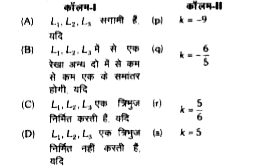कथन -1 : यदि α1,α2 तथा β1,β2 क्रमशः ax2+bx+c=0 तथा px2+qx+r=0 के मूल है यदि निकाय के समीकरणों α1y+α2z=0 तथा β1y+β2z=0 के अशून्य हल हो, तो b2q2=acpr
कथन-2 : यदि समीकरणों a1x+b1y=0 तथा a2x+b2y=0 का एक अशून्य हल होगा यदि ∣∣∣a1b1a2b2∣∣∣=0
कथन-1 सही है, कथन-2 सही है, कथन-1 के लिए कथन-2 का स्पष्टीकरण सही है।
कथन-1 सही है, कथन-2 सही है, कथन-1 के लिए कथन-2 का स्पष्टीकरण नहीं सही है।
कथन-1 सही है, कथन-2 गलत है।
कथन-1 गलत है, कथन-2 सही है।
The correct Answer is:A
Step by step video, text & image solution for कथन -1 : यदि alpha_(1),alpha_(2) तथा beta_(1),beta_(2) क्रमशः ax^(2)+bx+c=0 तथा px^(2)+qx+r=0 के मूल है यदि निकाय के समीकरणों alpha_(1)y+alpha_(2)z=0 तथा beta_(1)y+beta_(2)z=0 के अशून्य हल हो, तो (b^(2))/(q^(2))=(ac)/(pr) कथन-2 : यदि समीकरणों a_(1)x+b_(1)y=0 तथा a_(2)x+b_(2)y=0 का एक अशून्य हल होगा यदि |(a_(1),b_(1)),(a_(2),b_(2))|=0 by Maths experts to help you in doubts & scoring excellent marks in Class 12 exams.
Updated on:21/07/2023Topper's Solved these Questions
- सारणिक तथा आव्यूह Book:ERRORLESS HINDIChapter:सारणिक तथा आव्यूह Exercise:JEE ADVANCED MORE THAN ONE CORRECT ANSWERS (Comprehension type questions) (Passage-I)
Explore 6 Videos
- सारणिक तथा आव्यूह Book:ERRORLESS HINDIChapter:सारणिक तथा आव्यूह Exercise:JEE ADVANCED MORE THAN ONE CORRECT ANSWERS (Comprehension type questions) (Passage-III)
Explore 6 Videos
- सारणिक तथा आव्यूह Book:ERRORLESS HINDIChapter:सारणिक तथा आव्यूह Exercise:EXERCISE
Explore 262 Videos
- सरल रेखा Book:ERRORLESS HINDIChapter:सरल रेखा Exercise:JEE ADVANCE (Matrix Match type questions)
Explore 4 Videos
Similar Questions
माना कि p एक विषम अभाज्य संख्या है तथा Tp,2×2 आव्यूहों का निम्न समुच्चय है
Tp={A=[abca]:a,b,c∈{0,1,2,.............p−1}}
Tp में ऐसे A की संख्या जो सममित या विषम सममित अथवा दोनों प्रकार के हो एवं जिनके लिए det(A),p से विभाज्य है, निम्न है
View Solutionमाना A=⎡⎢⎣100210321⎤⎥⎦ तथा U1,U2 व U3,3×3 आव्यूह U के कॉलम है। यदि कॉलम आव्यूह U1,U2 तथा U3,AU1=⎡⎢⎣100⎤⎥⎦,AU2=⎡⎢⎣230⎤⎥⎦,AU3=⎡⎢⎣231⎤⎥⎦ को संतुष्ट करते है, तब निम्न प्रश्नो के उत्तर दीजिए
|U| का मान है
View Solution∣∣ ∣ ∣∣111cos(nx)cos(n+1)xcos(n+2)xsin(nx)sin(n+1)xsin(n+2)x∣∣ ∣ ∣∣ निर्भर नहीं करता है
View Solution
View SolutionLet α1,β1 be the roots x2−6x+p=0and α2,β2 be the roots x2−54x+q=0. If α1,β1,α2,β2 form an increasing G.P., then sum of the digits of the value of (q−p) is ___________.
View SolutionIf the roots of a_(1)x^(2)+b_(1)x+c_(1)=0 are alpha_(1),beta_(1) and those of a_(2)x^(2)+b_(2)x+c_(2)=0 are alpha_(2),beta_(2) such that alpha_(1)alpha_(2)=beta_(1)beta_(2)=1 then
View Solution[[(| x + y |) / (| x | + | y |), alpha_ (1), beta_ (1) alpha_ (2), (| y + z |) / (| y | + | z | ), beta_ (2)], (alpha_ (3) | x + z |) / (| x | + | z |), beta_ (3))]]
View SolutionLet alpha_(1),alpha_(2) and beta_(1),beta_(2) be the roots of the equation ax^(2)+bx+c=0 and px^(2)+qx+r=0 respectively.If the system of equations alpha_(1)y+alpha_(2)z=0 and beta_(1)y_(beta-)2z=0 has a non trivial solution then prove that (b^(2))/(q^(2))=(ac)/(pr)
View SolutionProve that ∣∣ ∣ ∣∣a1α1+b1β1a1α2+b1β2a1α3+b1β3a2α1+b2β1a2α2+b2β2a2α3+b2β3a3α1+b3β1a3α2+b3β2a3α3+b3β3∣∣ ∣ ∣∣=0.
View SolutionStatement 1: If the system of equations a1x+b1y+c1z=0,a2x+b2y+c2z=0 and a3x+b3y+c3z=0 have a solution (α,β,γ) such that αβγ≠0 then for any other non trivial solution (α1,β1,γ1),α1.β1.γ1≠0.
because
Statement 2 : If α,β,γ is any non trivial solution of the equations a1x+b1y+c1z=0,a2x+b2y+c2z=0 and a3x+b3y+c3z=0, then αβγ≠0.
View Solutionयदि दो रेखाओ के दिक् अनुपात a1,b1,c1 तथा a2,b2,c2 है तो वे परस्पर लंबवत होगी, यदि -
View SolutionConsidered equation ax^(2) + bx + c=0 Origin of alpha_(1),alpha_(2) Is and equation px^(2) + qx + r=0 Origin of beta_(1),beta_(2) Is If the equation body alpha_(1)y + alpha_(2)z=0 And beta_(1)y + beta_(2)z=0 Is a (non-trivial) solution, then prove b^(2)/q^(2) =(ac)/(pr)
View SolutionStatement - 1: If alpha_(1),alpha_(2) And beta_(1),beta_(2) Respectively ax^(2)+bx+c=0 And px^(2)+qx+r=0 The origin of the equation is if alpha_(1)y+alpha_(2)z=0 And beta_(1)y+beta_(2)z=0 If there are non-resolves (b^(2))/(q^(2))=(ac)/(pr) Statement-2: If the equations a_(1)x+b_(1)y=0 And a_(2)x+b_(2)y=0 Will have a nonzero solution if |(a_(1),b_(1)),(a_(2),b_(2))|=0
View SolutionThe lines a1x+b1y+c1=0 and a2x+b2y+c2=0 are perpendicular to each other, then.............. A) a1b2−b1a2=0 B) a1a2+b1b2=0
C) a21b2+b21a2=0 D) a1b1+a2b2=0
View Solutionयदि समीकरणों ax2+bx+c=0 तथा px2+qx+r=0 के मूल क्रमश: α1,α2 व β1,β2 हों एवं समीकरण निकाय α1y+α2z=0 व β1y+β2z=0 का एक अशून्य हल हो, तो
View Solution